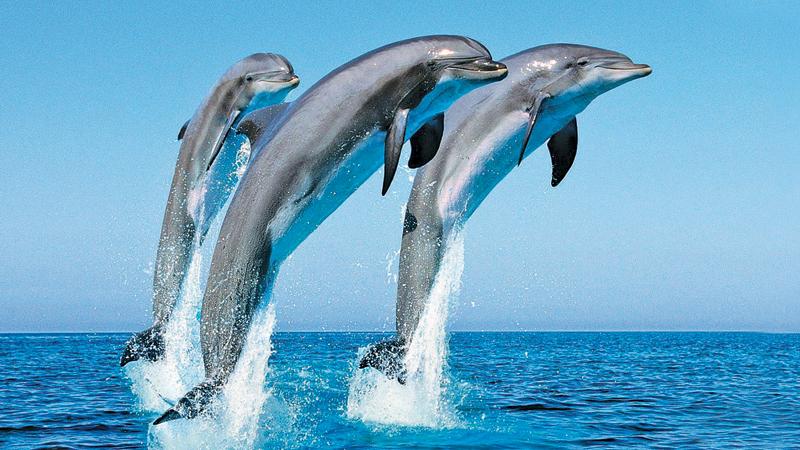
Dolphins and porpoises are all mammals that belong to the order Cetacea. The difference boils down to their faces, fins and bodies. Dolphins generally have prominent, long ‘beaks’ and cone-shaped teeth. Porpoises have smaller mouths and spade-shaped teeth. Dolphins are generally leaner than porpoises, and have a curved dorsal fin, while porpoises are more robust and have a triangular dorsal fin.
Dolphins

Dolphins are cetacean mammals closely related to whales and porpoises.
There are almost forty species of dolphin in 17 genera. They vary in size from 1.2 m and 40 kg (Maui's dolphin), up to 9.5 m and 10 tonnes (the orca or killer whale). They are found worldwide, mostly in the shallower seas of the continental shelves and are carnivores, eating mostly fish and squid.
Dolphins have a streamlined fusiform body, adapted for fast swimming. The tail fin, called the fluke, is used for propulsion while the pectoral fins, together with the entire tail section, provide directional control. The dorsal fin, in those species which have one, provides stability while swimming. Though varying by species, basic colouration patterns are shades of grey, usually with a lighter underside and often with lines and patches of different hue and contrast.
The head contains the melon, a round organ used for echolocation. In many species, elongated jaws form a distinct beak; species such as the bottlenose have a curved mouth which looks like a fixed smile. Some species have up to 250 teeth.
Dolphins are often regarded as one of Earth's most intelligent animals, though it is hard to say just how intelligent. Most dolphins have acute sight, both in and out of the water, and they can hear frequencies ten times or more above the upper limit of adult human hearing.
Though they have a small ear opening on each side of their head, it is believed hearing underwater is also, if not exclusively, done with the lower jaw, which conducts sound to the middle ear via a fat-filled cavity in the lower jaw bone.
Porpoises

Porpoises are small cetaceans of the family Phocoenidae; they are related to whales and dolphins. They are distinct from dolphins, although the word “porpoise” has been used to refer to any small dolphin, especially by sailors and fishermen. The most obvious visible difference between the two groups is that porpoises have shorter beaks and flattened spade-shaped teeth distinct from the conical teeth of dolphins.
Porpoises, divided into six species, live in all oceans, and mostly near the shore. Porpoises tend to be smaller but stouter than dolphins.
They have small, rounded heads and blunt jaws instead of beaks. While dolphins have a round, bulbous “melon”, porpoises do not. Their teeth are spade-shaped, whereas dolphins have conical teeth. In addition, a porpoise's dorsal fin is generally triangular, rather than curved like that of many dolphins and large whales.
These animals are the smallest cetaceans, reaching body lengths up to 2.5 metres; the smallest species is the vaquita, reaching up to 1.5 metres. In terms of weight, the lightest is the finless porpoise at 30 to 45 kilograms, and the heaviest is Dall's porpoise at 130 to 200 kilograms. Porpoises prey on fish, squid and crustaceans. Although they are capable of dives up to 200 m, they generally hunt in shallow coastal waters.
They are found most commonly in small groups of fewer than ten individuals, referred to as pods.
Porpoises are fast swimmers-Dall's porpoise is said to be one of the fastest cetaceans, with a speed of 55 km/h.
Porpoises tend to be less acrobatic than dolphins.

